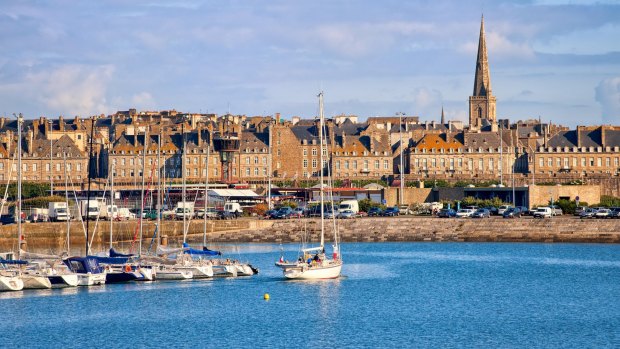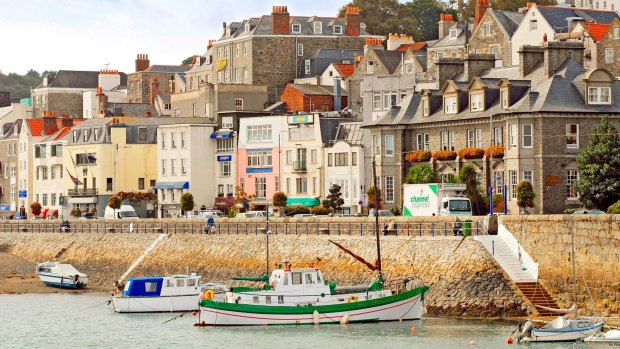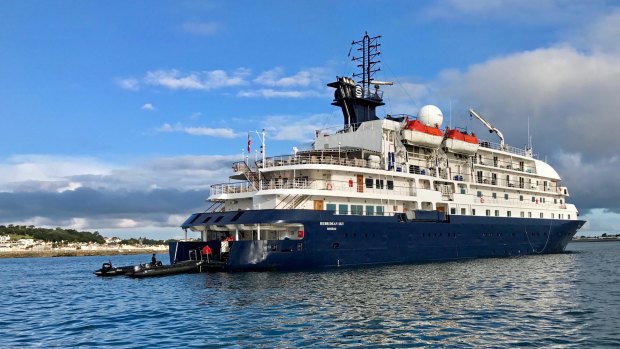This was published 5 years ago
Small-ship cruising, the French Atlantic: From Guernsey to Gironde, nothing but delightful

The walled city of Saint-Malo, Brittany.Credit: Alamy
Portsmouth is quite the departure point for a maritime adventure.
As Hebridean Sky groans and rattles away from the quay, I can see the masts of Admiral Nelson's HMS Victory and the sullen grey superstructure of Queen Elizabeth, the British navy's just-completed aircraft carrier.
Our own ship seems like a bathtub toy in comparison, raffish and salty, with brass railings and teak decks rubbed smooth by wind and the passing feet of deck-gawking passengers. I feel the usual surge of excitement at this setting off by sea to parts unknown.

St Peter Port, Guernsey.Credit: Alamy
The narrow harbour entrance is dotted with island forts that glare towards the rival French. Then we're out onto the Solent and Hebridean Sky surges forward like a hound scenting a truffle. This small-ship is made for adventure, with decks named after Shackleton and Amundsen, an expedition crew at the ready, and rubbery Zodiacs lashed down on its decks like errant whales.
We'll skirt around the edge of Europe, distanced from major cruise crowds until we reach our final port at Barcelona, where behemoth vessels loaded with waterslides and swimming pools are the resort giants to our boutique-hotel dwarf. This first part of our journey is a textbook demonstration of what small-ship cruising is all about: harbours too small for megaships, obscure places with unexpected pleasures, and an easy on-board camaraderie of like-minded voyagers.
Next morning, under a silvery sky, we're anchoring off St Peter Port in the Channel Islands to the twanging of yacht cables. We pile into Zodiacs on a harbour lined with tall grey-roofed houses and flanked by a fortified promontory that has guarded the island of Guernsey since Henry III first hefted a sword. The town has the raffish air of many small ports, with shrieking seagulls, nautically named pubs, hilly cobbles and unexpected sea glimpses down plunging streets.

Made for adventure: Hebridean Sky.
The fishermen have mostly gone, though, and the bankers have moved in. St Peter Port is a well-heeled enclave of jewellery shops and flowery cafés that we tour with Judy, the first of many good local APT guides. She's witty about life on this small island. "Before internet shopping, if you went to a Christmas party you'd probably see five other ladies wearing the same dress, but looking slimmer. We all had to shop in the same short high street, it was horrible!"
The town seems British, but not quite. Church plaques honour those who died in colonial outposts and the architecture is Regency, but Victor Hugo was the town's most famous resident (he polished off Les Misérables here) and Nazi pillboxes litter the Guernsey shoreline. It's our first intimation of nearby France but when, over lunch, Hebridean Sky takes us 11 nautical miles across to tiddly Sark, we seem transported back to an England lost a century ago.
We resort to Zodiacs again, motoring into Sark's minuscule harbour hidden in a cliff crevice. We tour the traffic-less island on a cart pulled by a horse called Frodo, a phlegmatic black monster with hooves the size of dinner plates. We clop around a Hobbit's shire of sunken country paths flanked by hydrangea and fuchsia bushes. Dogs flop and red admirals flutter. Stone cottages lurk behind briar roses. Afternoon tea features scones with lashings of clotted cream. Behind enclosed granite walls, flowerbeds erupt at La Seigneurie, the petite castle of Sark's semi-feudal overlord.
Next day we approach the French coast at Saint-Malo. It's another port city to gladden the hearts of the maritime minded, approached past lighthouses and sea-girt fortifications. Our little ship slides into a lock and ties up in the inner harbour, under a citadel that was once the haunt of pirates and explorers such as Jacques Cartier, who claimed Canada for France. Tall granite buildings are squeezed behind walls layered with history.
I walk the ramparts, the town's narrow street canyons below me on one side, tidal sands and cobalt waves on the other. Occasionally steps lead downwards, allowing kids to splash and squabble over sandcastles by a chilly, sun-sparkled sea.
It's a glorious sail away on Hebridean Sky that evening, trailed by show-offs on jet skis and breeze-tossed gulls screeching like kids on a rollercoaster. By morning, though, the Bay of Biscay lives up to its reputation. Rain lashes the windows of my cabin. Framed polar photographs creak against corridor walls, and the ship lurches and shudders.
Passengers cooperate on a puzzle in the ship's library and gossip in the lounge, comparing notes. (Some spent yesterday on an excursion to Mont Saint-Michel, Brittany's famous medieval island abbey; others visited an oyster farm). By the time we reach Belle-Île, though, the wind has died to dainty sobs and the sea's slosh has quietened. We scramble into Zodiacs and nose cautiously towards damp cliffs.
The sky is grey as old sheets but can't cover up the beauty of this island outpost, ringed by rock stacks and sandy coves. We stop at a lighthouse pounded on two sides by waves. The Gulf Stream gives Belle-Île a lush green interior and faintly Mediterranean air despite the weather. Monet and Matisse painted fishing-port Sauzon's pastel houses reflected in the harbour, where fishermen untangle langoustines from orange nets. Tour over, I spend my free time shuffling along the waterfront, rain-dampened but exhilarated.
It's the unexpected that I enjoy most about small-ship cruising. Belle-Île is just such a place. I'd struggle to explain precisely why anyone should visit. How to convey the simple joy of a galette (Breton pancake) inside a slate-trimmed cottage as the rain dribbles down the window panes? The pleasures of an island with no traffic lights, villages named for Celtic saints, and wild Impressionist seascapes? In a tourist world of bucket lists and big-name sights, Belle-Île is a time-out day of slow pleasures and island charm.
On our last day in France, we dock at Le Verdon-sur-Mer at the mouth of the Gironde Estuary. A coach takes us past saltpans, fish farms and suburban supermarkets into Bordeaux, where we're let loose in one of France's loveliest cities. Stately wine-merchants' mansions, Gothic chapels and tree-shaded squares grace a sweep of the Garonne River. Lunchtime restaurants offer a temptation of truffles, oysters and Michelin-star cuisine. The road back to Hebridean Sky winds past honey-coloured chateaux with skirts of vines, unfurling in the sunshine.
That evening there are French wines in the ship's restaurant, with Roquefort cheese tart, then pan-seared trout fillet in beurre blanc. Spain and Portugal are just over the horizon, promising Cadiz lobster, flamboyant architecture and lemon-scented hillsides. A week down, another week to go, and surely a different sort of adventure ahead.
FIVE BIG ENCOUNTERS
As this APT cruise sails southwards from Portsmouth, it passes through some of Europe's most important geographical landmarks and several cultural and historical oddities. Beyond individual ports of call, here are five bigger encounters along the way.
1. ENGLISH CHANNEL
This strip of water links the Atlantic and North Sea, and separates England from France. The French simply call it The Sleeve, the Bretons call it the Sea of Brittany. In the Channel Islands and parts of Brittany, its funnelling effect can create six-metre tides. For centuries, the Channel has protected Britain from continental invasions. It's now the world's busiest shipping route, with about 500 vessels sailing through daily. Northbound ships sail the French side, southbound ships the English.
2. CHANNEL ISLANDS
The French call these the Anglo-Norman islands, and indeed they're arguably the last remnant of the duchy of Normandy whose army under William the Conqueror famously invaded England in 1066. The archipelago is neither part of the United Kingdom, Commonwealth nor European Union and consists of two quite differently organised British Crown dependencies, Jersey and Guernsey (the latter incorporates islands Sark and Alderney). Tourism and offshore banking keep their economies afloat. See visitchannelislands.com
3. BRITTANY
The original Little Britain, as its fourth-century Celt settlers called it, is a former independent duchy (until 1532) and current distinct cultural region of northwest France that juts into the Atlantic and has tenaciously clung to its traditions, Breton language and music, and independent attitudes. You'll see Brittany's black-and-white flag fluttering all along the coast. The region is characterised by a jagged, convoluted coastline, old seaports, medieval fortresses and Celtic ruins. See brittanytourism.com
4. BAY OF BISCAY
This big bite out of Europe's coastline off western France and northern Spain is notorious among sailors, since shallow waters (created by a continental shelf) and exposure to ocean swells create some of the Atlantic's wildest weather. Winds can near hurricane speed. Fortunately for cruise passengers, its fiercest storms arrive mostly in the winter off season. Look out for dolphins and whales; the bay is perhaps the best place in the world to spot relatively unknown beaked whales.
5. GIRONDE ESTUARY
Formed by the confluence of the Garonne and Dordogne rivers, this is western Europe's largest estuary, 12 kilometres wide at its mouth. (The three waterways are visited on APT river cruises from Bordeaux). The banks are flanked by marshes, as well as limestone cliffs and the prestigious vineyards of the Médoc wine region. The Gironde was an important medieval Plantagenet trade route to Bordeaux, and also has three World Heritage-listed, seventeenth-century fortresses. See france-atlantic.com
TRIP NOTES
MORE
CRUISE
The writer travelled on APT's 15-day Southern European Sojourn itinerary between London and Barcelona priced from $15,995 per person including shore excursions, gratuities and beverages. Phone 1300 196 420. See aptouring.com.au
Brian Johnston travelled as a guest of APT.
Sign up for the Traveller Deals newsletter
Get exclusive travel deals delivered straight to your inbox. Sign up now.